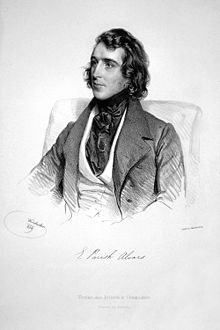Elias Parish Alvars

Elias Parish Alvars (born February 28, 1808 in Teignmouth , Devonshire , † January 25, 1849 in Vienna ) was an English harpist and composer .
Life
Elias Parish Alvars, actually Eli Parish, was born the son of an organist. He learned the harp from Robert Nicolas-Charles Bochsa . An attempt to be accepted into the newly founded Royal Academy of Music in 1822 failed. In 1828 he took composition lessons from Maximilian Josef Leidesdorf in Florence.
In 1831 Parish Alvars undertook a concert tour to Germany (including Bremen and Hamburg), in 1832 he traveled to Constantinople at the invitation of the Russian ambassador . Another concert tour to Italy followed in 1834. In 1836 he moved to Vienna , where he made friends with Carl Czerny , studied composition with Simon Sechter and worked as a soloist at the Court Opera Theater. There he married his student Melanie Lewy (1823-1856), a sister of Richard Lewy . In the following years he made extensive trips, including a. to the Middle East , to Naples, Milan, London, Prague, Berlin and Gotha . In 1846 he made the acquaintance of Felix Mendelssohn in Leipzig . In 1847 he was appointed imperial chamber virtuoso in Vienna. He died of lung failure. His grave is in the Sankt Marxer Friedhof .
meaning
Parish Alvars enjoyed an international reputation as a harp virtuoso. He was one of the first to successfully use the new possibilities of the double pedal harp and set standards in the development of modern playing technique on this instrument. The French composer Hector Berlioz wrote about him:
- “In Dresden I got to know the great English harp virtuoso Parish-Alvars [...] He is the Liszt of the harp! One cannot imagine what graceful or energetic effects, original runs, unheard-of sound effects he can achieve, [...] The advantage of the new harps that you can tune two strings to the same note by moving the pedals twice, brought him to combinations that, when you see them written, seem impracticable. "
In the "Wiener Allgemeine Musik-Zeitung" one reads in a review of a concert given on January 2nd, 1848:
- “Mr. Parish-Alvars moved on his own land in his great Concerto in C minor for harp with accompaniment of the orchestra. This was finally again a concert as one can only expect from an artist, a concert in the sense that the great masters Beethoven, Hummel, Mendelssohn etc. understood it, a whole, articulated, performed, sublime piece of music! "
In Vienna- Liesing (23rd district), Alvarsgasse has been named in his honor since 1954 .
plant
Parish Alvars composed especially for his instrument, including four concertos for harp and orchestra, a concertino for two harps and orchestra as well as numerous fantasies, variations, transcriptions and etudes. But he also wrote a symphony in E minor (1845). His style is shaped by contemporary Italian opera, but also took influences from Felix Mendelssohn. Voyage d'un Harpiste en Orient op.62 for harp solo uses Turkish and Greek melodies that he had got to know on his travels.
literature
- Constantin von Wurzbach : Parish-Alvars, Elias . In: Biographisches Lexikon des Kaiserthums Oesterreich . 21st part. Imperial-Royal Court and State Printing Office, Vienna 1870, p. 301 f. ( Digitized version ).
- Friedrich Blume (Ed.): Music in the past and present . 1st edition. 1949-1986.
- Floraleda Sacchi : Elias Parish Alvars, Life, Music, Documents: annotated catalog of his works for harp, piano, orchestra and voice. Odilia Publishing, 1999, ISBN 3-9521367-1-9 .
- Floraleda Sacchi: Elias Parish Alvars. In: HARPA. n. 30, Primavera 1999 Download ( Memento from July 25, 2011 in the Internet Archive ) (PDF; 1.3 MB)
- Floraleda Sacchi: Parish Alvars in Italy. World Harp Congress Review, 2008.
- Floraleda Sacchi: Introducing Parish Alvars. In: American Harp Journal. Winter 2008. Download ( Memento from July 25, 2011 in the Internet Archive ) (PDF; 3.5 MB)
Web links
- CV at Klassika.info
- Parish-Alvars, Elias. In: Isidore Singer (Ed.): Jewish Encyclopedia . Funk and Wagnalls, New York 1901-1906.
- ParishAlvars.com
Individual evidence
- ^ Wiener Zeitung , February 1, 1849, p. 310
- ^ Hector Berlioz: Memoirs. Athenäum Verl., Königstein / Ts., 1985, ISBN 3-7610-8388-2 , pp. 281/282.
- ^ Wiener Allgemeine Musik-Zeitung, Volumes 7–8
| personal data | |
|---|---|
| SURNAME | Parish Alvars, Elias |
| ALTERNATIVE NAMES | Parish, Eli |
| BRIEF DESCRIPTION | English harpist and composer |
| DATE OF BIRTH | February 28, 1808 |
| PLACE OF BIRTH | Teignmouth , Devonshire |
| DATE OF DEATH | January 25, 1849 |
| Place of death | Vienna |
